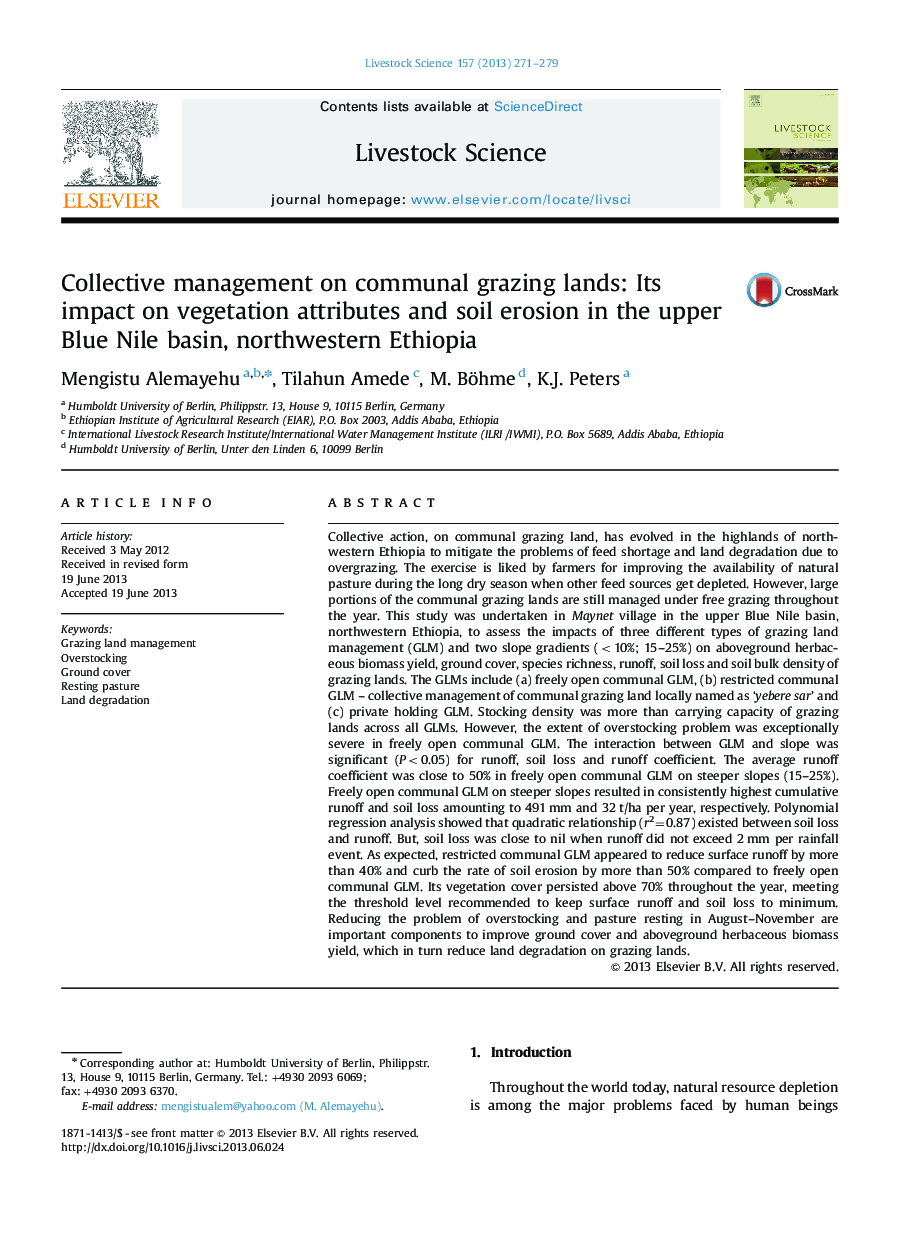| کد مقاله | کد نشریه | سال انتشار | مقاله انگلیسی | نسخه تمام متن |
|---|---|---|---|---|
| 5790371 | 1109492 | 2013 | 9 صفحه PDF | دانلود رایگان |
عنوان انگلیسی مقاله ISI
Collective management on communal grazing lands: Its impact on vegetation attributes and soil erosion in the upper Blue Nile basin, northwestern Ethiopia
ترجمه فارسی عنوان
مدیریت جمعی در زمین های کمپنی مشترک: تاثیر آن بر ویژگی های گیاهی و فرسایش خاک در حوضه بالایی آبی نیل، شمال غربی اتیوپی
دانلود مقاله + سفارش ترجمه
دانلود مقاله ISI انگلیسی
رایگان برای ایرانیان
کلمات کلیدی
موضوعات مرتبط
علوم زیستی و بیوفناوری
علوم کشاورزی و بیولوژیک
علوم دامی و جانورشناسی
چکیده انگلیسی
Collective action, on communal grazing land, has evolved in the highlands of northwestern Ethiopia to mitigate the problems of feed shortage and land degradation due to overgrazing. The exercise is liked by farmers for improving the availability of natural pasture during the long dry season when other feed sources get depleted. However, large portions of the communal grazing lands are still managed under free grazing throughout the year. This study was undertaken in Maynet village in the upper Blue Nile basin, northwestern Ethiopia, to assess the impacts of three different types of grazing land management (GLM) and two slope gradients (<10%; 15-25%) on aboveground herbaceous biomass yield, ground cover, species richness, runoff, soil loss and soil bulk density of grazing lands. The GLMs include (a) freely open communal GLM, (b) restricted communal GLM - collective management of communal grazing land locally named as 'yebere sar' and (c) private holding GLM. Stocking density was more than carrying capacity of grazing lands across all GLMs. However, the extent of overstocking problem was exceptionally severe in freely open communal GLM. The interaction between GLM and slope was significant (P<0.05) for runoff, soil loss and runoff coefficient. The average runoff coefficient was close to 50% in freely open communal GLM on steeper slopes (15-25%). Freely open communal GLM on steeper slopes resulted in consistently highest cumulative runoff and soil loss amounting to 491Â mm and 32Â t/ha per year, respectively. Polynomial regression analysis showed that quadratic relationship (r2=0.87) existed between soil loss and runoff. But, soil loss was close to nil when runoff did not exceed 2Â mm per rainfall event. As expected, restricted communal GLM appeared to reduce surface runoff by more than 40% and curb the rate of soil erosion by more than 50% compared to freely open communal GLM. Its vegetation cover persisted above 70% throughout the year, meeting the threshold level recommended to keep surface runoff and soil loss to minimum. Reducing the problem of overstocking and pasture resting in August-November are important components to improve ground cover and aboveground herbaceous biomass yield, which in turn reduce land degradation on grazing lands.
ناشر
Database: Elsevier - ScienceDirect (ساینس دایرکت)
Journal: Livestock Science - Volume 157, Issue 1, October 2013, Pages 271-279
Journal: Livestock Science - Volume 157, Issue 1, October 2013, Pages 271-279
نویسندگان
Mengistu Alemayehu, Tilahun Amede, M. Böhme, K.J. Peters,
